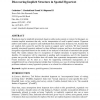Free Online Productivity Tools
i2Speak
i2Symbol
i2OCR
iTex2Img
iWeb2Print
iWeb2Shot
i2Type
iPdf2Split
iPdf2Merge
i2Bopomofo
i2Arabic
i2Style
i2Image
i2PDF
iLatex2Rtf
Sci2ools
HT
1993
ACM
1993
ACM
Searching for the Missing Link: Discovering Implicit Structure in Spatial Hypertext
Hypertexts may be implicitly structured, based on either node content or context. In this paper, we examine implicit structures that rely on the interpretation of node’s spatial context. Hypertext authors and readers can perceive and understand these idiosyncratic structures, but, because they are implicit, they cannot be used by the system to support users’ activities. We have explored spatially structured hypertext authored in three different systems, and have developed heuristic recognition algorithms based on the results of our analyses of the kinds of structures that people build. Our results indicate that (1) recognition of implicit structures in spatial hypertext is feasible, (2) interaction will be important in guiding such recognition, and (3) the hypertext system can provide layout facilities that will render later systematic interpretation much easier. Found structures can be used as a basis for supporting information management, as a straightforward way of promoting kn...
| Added | 09 Aug 2010 |
| Updated | 09 Aug 2010 |
| Type | Conference |
| Year | 1993 |
| Where | HT |
| Authors | Catherine C. Marshall, Frank M. Shipman III |
Comments (0)

